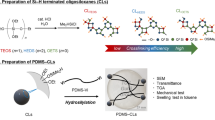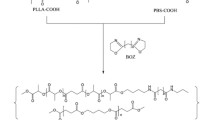Abstract
The commonly used coupling reagents in peptide synthesessuch as dicyclohexylcabodiimide, diisopropylcarbodiimide and3-ethyl-1(N,N-dimethyl)aminopropylcarbodiimide with or without1-hydroxybenzotriazole or N-hydroxysuccinimide have been used as polymerizing agents in the synthesis of elastic/plastic protein-based polymers. It was found that 3-ethyl-1(N,N-dimethyl)aminopropylcarbodiimide with 1-hydroxybenzotriazole gave equally good polymers comparable toconventional p-nitrophenol approach. Further, we present here the polymerization and characterization of structural andfunctional properties of poly(Val-Pro-Gly-Val-Gly), which is themost striking repeating sequence in the bovine and porcine elastins. The polymers obtained by both p-nitrophenol and 3-ethyl-1(N,N-dimethyl)aminopropylcarbodiimide approach werecharacterized by carbon-13 and proton nuclear magnetic resonancespectroscopy, differential scanning calorimetry, circular dichroism and fourier transform infrared spectroscopy. These results conclude that poly(Val-Pro-Gly-Val-Gly) obtained by bothmethods were identical in all respects of physical and chemicalproperties indicates that 3-ethyl-1(N,N-dimethyl)aminopropylcarbodiimide with 1-hydroxybenzotriazole method can be conveniently employed to synthesize these polymers.
Similar content being viewed by others
References
Urry, D.W., Bioelastics: ‘Bioelastics’ break new ground in the development of biomaterials, Res. and Dev., 30 (1989) 57–64.
Urry, D. W., Parker, T. M., Reid, M. C. and Gowda, D. C., Biocompatibility of the bioelastic materials, poly(GVGVP) and its γ-irradiation cross-linked matrix: Summary of generic biological test results, J. Bioctive Compatible Polym., 6 (1991) 263–282.
Urry, D. W., Gowda, D. C., Harris, C. and Cox, B. A., Development of bioelastic materials as biocompatible, transducible and degradable drug delivery matrices, Am. Chem. Soc. Poly. Chem. Div., 33 (1992) 84–85.
Urry, D. W.: 1992, Molecular machines: How motion and other functions of living organisms can result from reversible chemical changes, Angew. Chem. (German), 105, 859–883; Angew. Chem. Int., Ed. Engl., 32, 819–841.
Urry, D. W., Parker, T. M., Nicol, A., Pattanaik, A., Minehan, D. S., Gowda, D. C., Morrow, C. and McPherson, D. T., The capacity to vary the bioactive role of elastic protein-based polymers, Am. Chem. Soc. Div. Poly. Mat. Sci. and Eng., 66 (1992) 399–402.
Sandberg, L., Leslie, J., Leach, C., Trres, V., Smith, A. and Smith, D., Elastin covalent structure as determined by solidphase amino acid sequence, Pathol. Biol., 33 (1985) 266–274.
Yeh, H., Ornstein-Goldstein, N., Indik, Z., Sheppard, P., Anderson, N., Rosenbloom, J., Cicila, G., Yoon, K. and Rosenbloom, J. C., Sequence variation of bovine elastin mRNA due to alternative splicing, Collagen and Related Research, 7 (1987) 235–247.
Indik, Z., Yeh, H., Ornstein-Goldstien, N., Sheppard, P., Anderson, N., Rosenbloom, J., Peltonen, L. and Rosenbloom, J. C., Alternative splicing of human elastin mRNA indicated by sequence analysis of cloned genomic and complementary DNA, J. Proc. Natl. Acad. Sci. USA, 84 (1987) 5680–5684.
Smith, D. W., Sandberg, L. B., Leslie, B. H., Wolt, T. E., Minton, S. T., Myers, B. and Rucker, R. B., Primary structure of a chick tropoelastin peptide: Evidence for a collagen-like amino acid sequence, Biochem. Biophys. Res. Commun., 103 (1981) 880–885.
Sandberg, L. B., Soskel, N. T. and Leslie, J. B., Elastin structure, biosynthesis and relation, N. Engl. J. Med. 304 (1981) 566–579.
Urry, D.W., Free energy transduction in polypeptides and proteins based on inverse temperature transitions, Prog. Biophy. Molec. Biol., 57 (1992) 23–57.
Urry, D. W., Nicol, A., Gowda, D. C., Hoban, L. D., McKee, A., Williams, T., Olsen, D. B. and Cox, B. A., In Charles G. Gebelein, (Ed.), Medical Applications of Bioelastic Materials, Technomic Publishing, Atlanta, Georgia, 1993, pp. 82–103.
Urry, D. W., Nicol, A., McPherson, D. T., Xu, J., Shewry, P. R., Harris, C. M., Parker, T. M. and Gowda, D. C., In Handbook of Biomaterials and Applications, Marcel Dekker Inc., New York, 1995, pp. 2645–2699.
Urry, D. W. and Prasad, K. U., In D. W. Williams (Ed.), Biocompatibility of Tissue Analogues, CRC Press Inc., Boca Raton, Florida, 1985, pp. 89–116.
Prasad, K. U., Iqbal, M. A. and Urry, D. W., Utilization of 1-hydroxybenzotriazole in mixed anhydride coupling reactions, Int. J. Pept. and Protein Res., 25 (1985) 408–413.
Sheehan, J. C. and Hess, G. P., A new method of forming peptide bonds, J. Am. Chem. Soc., 77 (1955) 1067–1068.
Sheehan, J. C., Preston, J. and Cruickshank, P. A., A rapid synthesis of oligopeptide derivatives without isolation of intermediates, J. Am. Chem. Soc., 87 (1965) 2492–2493.
Luan, C. H., Parker, T. M., Gowda, D. C. and Urry, D. W., Hydropohobicity of amino acid residues: Differential scanning calorimetry and synthesis of the aromatic analogues of the polypentapeptides of elastin, Biopolymers, 32 (1992) 1251–1261.
Haris, P. I. and Chapman, D., Does fourier-transformed infrared spectroscopy provide useful information on protein structures?, TIBS, 1992, 328–333.
Jagannadham, M. V., Krishnamurhty, A. S. R., Husain, S. and Nagaraj, R., Conformations of hydrophobic peptides in trifluoroethanol, water and in solid state: A circular dichroism and fourier transform infrared study, Ind. J. Biochem. Biophys., 36 (1999) 422–428.
Reymond, M. T., Huo, S., Duggan, B., Wright, P. E. and Dyson, H. J., Contribution of increased length and intact capping sequences to the conformational preference for helix in a 31-residue peptide from the C terminus of myohemerythrin, Biochemistry, 36 (1997) 5234–5244.
Sonnichsen, F. D., Eyk, J. E. V., Hodges, R. S. and Sykes, B. D., Effect of trifluoroethanol on protein secondary structure: An NMR and CD study using a synthetic actin peptide, Biochemistry, 31 (1992) 8790–8798.
Urry, D. W., Shaw, R. G. and Prasad, K. U., Polypentapeptide of elastin: Temperature dependence of ellipticity and correlation with elastomeric force, Biochem. Biophys. Res. Commun., 130 (1985) 50–57.
Anwer, M. K. and Spatola, A. F., An advantageous method for the rapid removal of hydrogenolysable protecting groups under ambient conditions; Synthesis of leucine-enkephalin, Synthesis, 1980, 929–932.
Author information
Authors and Affiliations
Corresponding author
Rights and permissions
About this article
Cite this article
Ramesha Baba, A., Channe Gowda, D. Utilization of 3-ethyl-1(N,N-dimethyl)aminopropylcarbodiimide (EDCI)/1-hydroxybenzotriazole (HOBt) as a polymerizing agent. Letters in Peptide Science 8, 309–318 (2001). https://doi.org/10.1023/A:1016269919210
Issue Date:
DOI: https://doi.org/10.1023/A:1016269919210




